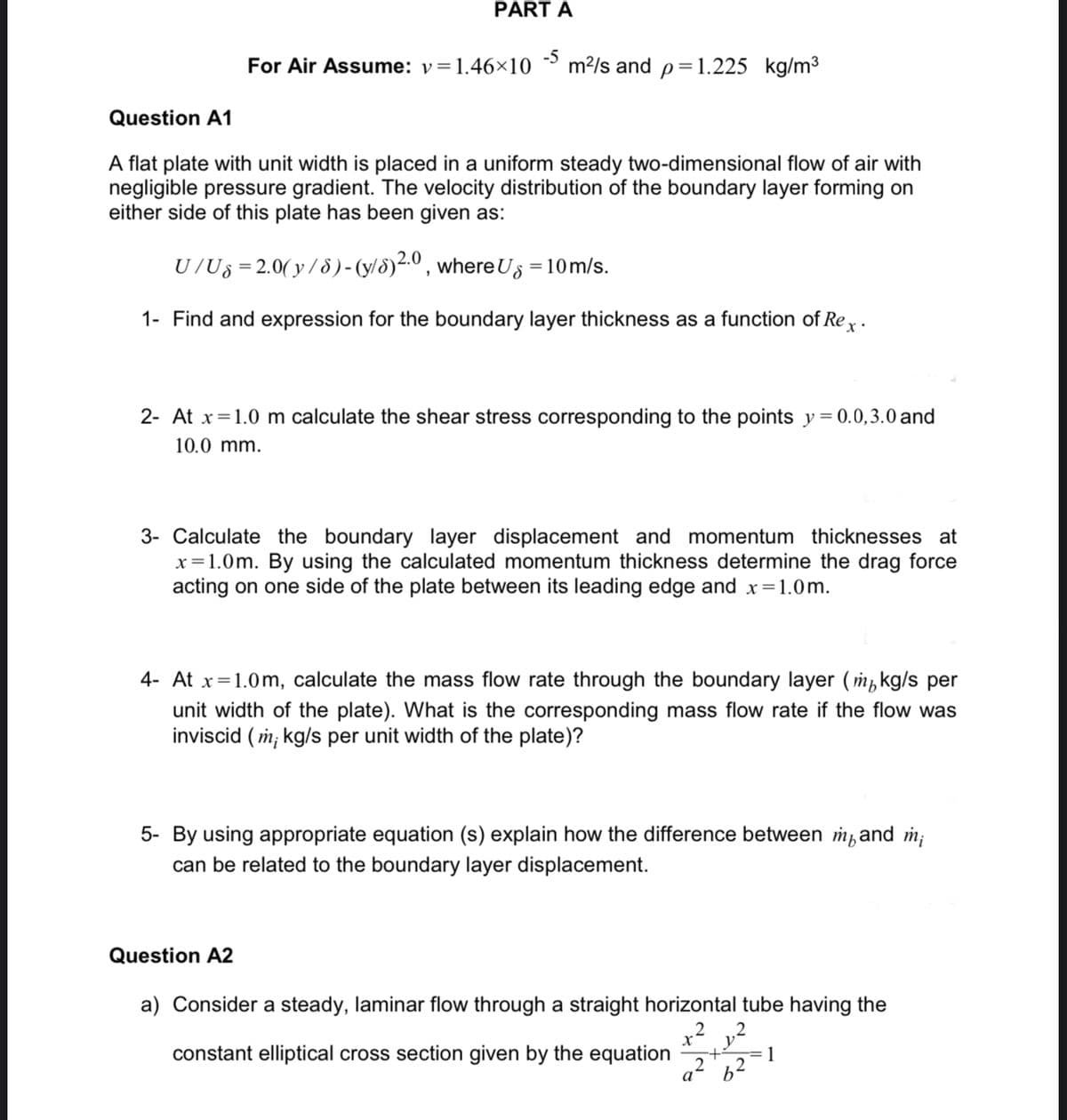For Air Assume: v=1.46×10 -5 m²/s and p = 1.225 kg/m³ Question A1 A flat plate with unit width is placed in a uniform steady two-dimensional flow of air with negligible pressure gradient. The velocity distribution of the boundary layer forming on either side of this plate has been given as: U/U8 = 2.0(y/ 8) - (y/8)2.0, where Us = 10 m/s. 1- Find and expression for the boundary layer thickness as a function of Rex. 2- At x=1.0 m calculate the shear stress corresponding to the points y=0.0,3.0 and 10.0 mm. 3- Calculate the boundary layer displacement and momentum thicknesses at x=1.0m. By using the calculated momentum thickness determine the drag force acting on one side of the plate between its leading edge and x = 1.0m. 4- At x=1.0m, calculate the mass flow rate through the boundary layer (mkg/s per unit width of the plate). What is the corresponding mass flow rate if the flow was inviscid (m; kg/s per unit width of the plate)? 5- By using appropriate equation (s) explain how the difference between mand mi can be related to the boundary layer displacement.
For Air Assume: v=1.46×10 -5 m²/s and p = 1.225 kg/m³ Question A1 A flat plate with unit width is placed in a uniform steady two-dimensional flow of air with negligible pressure gradient. The velocity distribution of the boundary layer forming on either side of this plate has been given as: U/U8 = 2.0(y/ 8) - (y/8)2.0, where Us = 10 m/s. 1- Find and expression for the boundary layer thickness as a function of Rex. 2- At x=1.0 m calculate the shear stress corresponding to the points y=0.0,3.0 and 10.0 mm. 3- Calculate the boundary layer displacement and momentum thicknesses at x=1.0m. By using the calculated momentum thickness determine the drag force acting on one side of the plate between its leading edge and x = 1.0m. 4- At x=1.0m, calculate the mass flow rate through the boundary layer (mkg/s per unit width of the plate). What is the corresponding mass flow rate if the flow was inviscid (m; kg/s per unit width of the plate)? 5- By using appropriate equation (s) explain how the difference between mand mi can be related to the boundary layer displacement.
Principles of Heat Transfer (Activate Learning with these NEW titles from Engineering!)
8th Edition
ISBN:9781305387102
Author:Kreith, Frank; Manglik, Raj M.
Publisher:Kreith, Frank; Manglik, Raj M.
Chapter5: Analysis Of Convection Heat Transfer
Section: Chapter Questions
Problem 5.24P: Engine oil at 100C flows over and parallel to a flat surface at a velocity of 3 m/s. Calculate the...
Related questions
Question

Transcribed Image Text:PART A
-5
For Air Assume: v=1.46×10 m²/s and p =1.225 kg/m³
Question A1
A flat plate with unit width is placed in a uniform steady two-dimensional flow of air with
negligible pressure gradient. The velocity distribution of the boundary layer forming on
either side of this plate has been given as:
U /Us = 2.0(y/ 8) - (y/8)2.0, where U = 10 m/s.
1- Find and expression for the boundary layer thickness as a function of Rex.
2- At x=1.0 m calculate the shear stress corresponding to the points y=0.0,3.0 and
10.0 mm.
3- Calculate the boundary layer displacement and momentum thicknesses at
x=1.0m. By using the calculated momentum thickness determine the drag force
acting on one side of the plate between its leading edge and x = 1.0m.
4- At x=1.0m, calculate the mass flow rate through the boundary layer (mkg/s per
unit width of the plate). What is the corresponding mass flow rate if the flow was
inviscid (m; kg/s per unit width of the plate)?
5- By using appropriate equation (s) explain how the difference between mand m
can be related to the boundary layer displacement.
Question A2
a) Consider a steady, laminar flow through a straight horizontal tube having the
constant elliptical cross section given by the equation
x² 12
62
=1
Expert Solution
This question has been solved!
Explore an expertly crafted, step-by-step solution for a thorough understanding of key concepts.
Step by step
Solved in 7 steps with 16 images

Knowledge Booster
Learn more about
Need a deep-dive on the concept behind this application? Look no further. Learn more about this topic, mechanical-engineering and related others by exploring similar questions and additional content below.Recommended textbooks for you

Principles of Heat Transfer (Activate Learning wi…
Mechanical Engineering
ISBN:
9781305387102
Author:
Kreith, Frank; Manglik, Raj M.
Publisher:
Cengage Learning

Principles of Heat Transfer (Activate Learning wi…
Mechanical Engineering
ISBN:
9781305387102
Author:
Kreith, Frank; Manglik, Raj M.
Publisher:
Cengage Learning